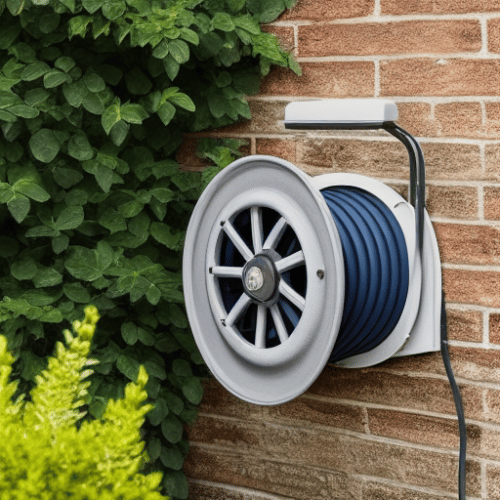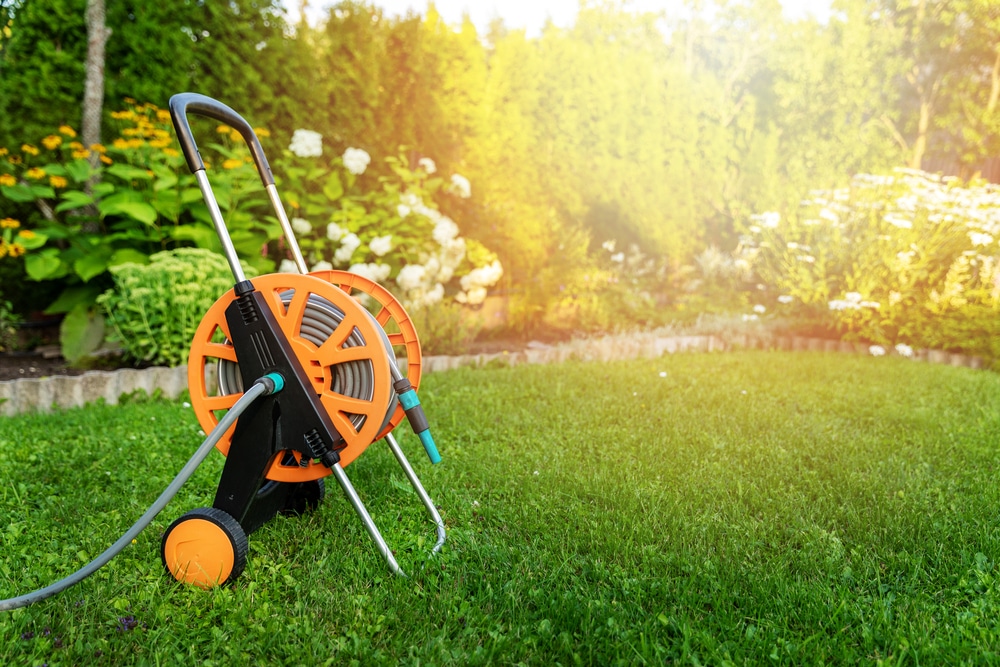Last Updated on
For those of us who love gardening, sometimes the most challenging part is tidying up at the end of the day. Or maybe you have a leak in your hose, and you need to replace it with a new one?
Either way, if you are looking for some effective ideas on how to put a garden hose on a reel, then we are here to help. In today’s article, we’re taking a look at the mastery behind these fittings and how to attach both.
Adding a Garden Hose to a Hose Reel
Below are some informative safety steps to follow when adding a hose to a reel.
Step 1: Disconnect the Hose Reel
The first task to complete is disconnecting the reel from the hose faucet spigot. Check to see if the spigot has an attachment for a vacuum breaker. These are important accessories that prevent contaminated water from going back into a fresh water supply. So if you don’t currently have one, it might be time to install one.
Step 2: Drain Out the Hose
Now it’s time to remove any old buildup of water inside of the garden hose reel. Ensure that you have an appropriate location for this, such as on a lawn. Once you remove the old hose, the water will flood out, so be sure to pick your location before this happens.
Step 3: Disconnect the Hose From the Coupling
Once your garden hose reel is completely extended, the water coupling will be visible. Disconnect this by hand, or use pliers if you’re struggling to do so. Then, take the new hose reel out of its packaging and spend a couple of minutes straightening it out. You may even need to leave the new hose reel out in the sun for several hours to help it to soften and be easier to then wind onto the reel.
Step 4: Insert the Rubber Washer
Place the rubber or vinyl washed into the bottom of the hose coupling. You’ll need a watertight seal against the drum of the hose reel to prevent any unwanted water splashes. Insert the end of the hose through the guided opening.
Then, thread the end onto the water coupling that is on the inner drum. Ensure that you tighten this thoroughly—using pliers, if applicable. But don’t tighten so much that you break any parts; the water coupling is made of delicate materials, so you’ll need not be too heavy-handed.
Step 5: Wind the Hose Reel Onto the Drum
Now it’s time to wind the hose reel onto the drum. To do so, feed the hose around the drum clockwise. Grip the hose reel as you turn the handle for extra help.
Step 6: Inspect the Results
Now it’s time to inspect what you’ve done so far. Begin by checking that the feeder hose connects via the faucet spigot. You’ll also want to check that there aren’t any cracks in the hose. Finally, inspect that the hose attaches to the reel drum with a clamp and is tightly clamped down.
How Does a Hose Reel Work?
Hose reels work by packing a large hose in a short duration, enabling you to water your garden when you need to without having to experience kinks and cranks in your hose. After you’ve used your hose, you can safely store it back onto the hose reel to keep it in excellent condition and readily available for the next time you need to water your garden.
Tips for Maintaining Your Garden Hose Reel

Hose reels are great for keeping your garden’s water source organised and close by, so it’s important that you take care of your plastic coils. Ensure that you use your reel properly, ensuring that you never tug at the mounting bracket or act roughly with the hose reel in general since these can lead to the hose reel getting damaged easily.
Another top tip for keeping your hose reel in good shape is to regularly clean its surface to wipe off dirt and debris. Doing so helps to keep the entire hose and reel looking clean and neat. Avoid using any harsh chemicals; some soapy water will do the job fine.
How to Choose a Hose Reel
Before you install your hose reel, you will have to purchase one. Below are some important factors you’ll want to consider during the buying process.
Length
One of the first features to look out for is the hose reel’s length. If you have a large garden, you’ll require a large hose reel to reach all areas. On the other hand, smaller gardens require smaller garden hoses. Either way, it’s better to choose the larger option than the smaller one.
For the best results, you might need to measure your garden before buying a hose reel; the more accurate you can be with your calculations, the better.
Transportation
You may need to move your hose reel around the garden while you’re watering the plants. In this case, you’ll want a reel system that’s lightweight and easy to move around. The last thing you want is to be lugging a heavy reel around your yard. Plus, a lightweight design prevents putting too much weight on the ground, which could destroy your grass and garden layout.
Durability
Bear in mind that you’ll store your garden hose reel outside, so it’s important that it’s made with waterproof, durable materials that are weather resistant. If you choose to install a stainless steel hose reel, opt for one that features a non-rusting substance on the exterior for the best weatherproof material. The last thing you want is to purchase wooden materials, for example, that don’t offer protection against rust.
Types
There are several types to consider:
Wall Mounted
A wall-mounted hose reel is stored on an exterior wall near a faucet. It’s typically around two to feet from the ground and, although it offers transportation limitations, you don’t have to worry about carrying the hose around your garden. In fact, this is an excellent option for smaller gardens. Alternatively, you can consider multiple wall-mounted reels for covering a large distance.
Cart Mounted
Designed with wheels, a cart-mounted garden hose reel is convenient for moving around and is handy when your hose becomes too heavy to lug around the garden.
Hose Cabinet
These aren’t all that common. They sit on the ground and offer a space to hide your hose when you’re not using it. You can play around with choosing a cabinet that suits your style and tastes, helping to add a little sense of you to your backyard.
Self-Retracting or Auto-Winding Reels
Finally, decide how you want the connecting hose to install to the reel. A self-retracting reel features a spring in the reel mechanism that tightens when the hose is unspooled. With a quick tug, the hose is retracted thanks to spring tension. There’s also a locking mechanism that prevents the hose from spooling back until you’re ready.
Alternatively, auto-winding reels are available with water pressure-driven hose retractors that feature a water piston to force out water. They’re also available as motor-driven, which comes with a battery to wind the hose in using a switch.
How Do You Care for Your Hose?
Knowing how to put a garden hose on a reel could make your gardening experience a more positive one, so we hope this article has helped. If your hose leaks, it could be that it hasn’t been installed correctly.
Before you connect the hose to the reel, ensure that you remove any old water to allow for more flexibility. Only then should you feed the hose back and forth on the reel. Do you have any tips or tricks for caring for your garden hose? Let us know your thoughts in the comments.
Amy is a U.K.-based writer and editor with a penchant for helping consumers find the best home products for their needs, as well as providing easily digestible guides for living better at home. Her dedication to her work means she can usually be found elbow-deep in research or hunting down samples of the latest and greatest on behalf of her readers.
An avid DIYer herself, Amy’s passion lies in teaching others how they too can achieve their dream homes by tackling some of those pesky projects themselves! Whether it’s building furniture from scratch or turning an old dresser into a coffee table, Amy is always happy to share what she knows about making your house feel like home without spending a fortune.



